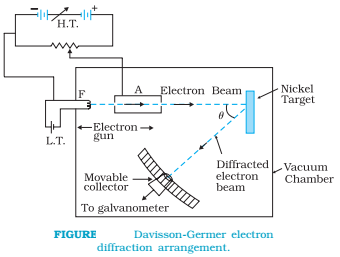
The experiment by Davisson’s and Germer’s provides experimental proof of the concept of wave nature of material particles.
The experimental arrangement used by Davisson and Germer is schematically shown in figure given below:

In the experiment, an electron gun was used to produce a beam of electrons. This fine beam of accelerated electrons was made to fall on a nickel crystal and atoms of the crystal scatter these electrons in different directions. The intensity of the electron beam, scattered in a given direction, is measured by the electron detector (collector). The detector can be moved on a circular scale and is connected to a sensitive galvanometer, which records the current. The deflection of the galvanometer is proportional to the intensity of the electron beam entering the collector. From the experiment, scientists observed the intensity of the scattered beam of electrons for different values of latitude angles or scattering angles which are the angles between the incident and the scattered electron beams.
The experiment was performed by varying the accelerating voltage from 44 V to 68 V. It was noticed that a strong peak appeared in the intensity (I) of the scattered electron for an accelerating voltage of 54V at a scattering angle θ = 50º.
The appearance of the peak in a particular direction is due to the constructive interference of electrons scattered from different layers of the regularly spaced atoms of the crystals. From the electron diffraction measurements, the wavelength of matter waves was found to be 0.165 nm.

